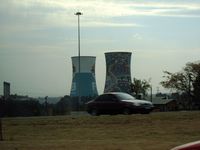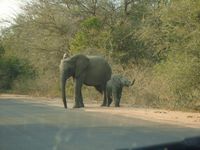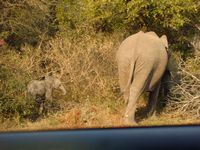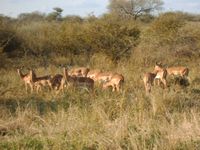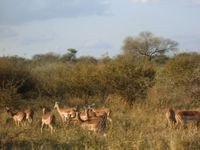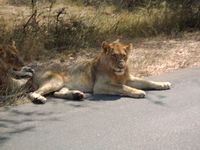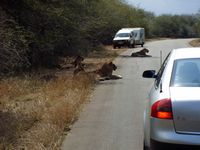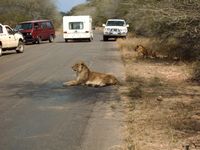Getting there and going around
Going to South Africa is very easy as long as you
choose to fly there. Planes come and go from all destinations so you shouldn't
have any problem finding the cheapest way to fly to ZA.
From Europe (we live in Belgium) London is probably the most logical place
to start from, but check your travel agent for rates. The Internet can
help but a travel agent can always negotiate the cheapest available rates.
Our travel agent at Degen Travel got us rates
that were 50% cheaper than what I had found on the web and the travel
agency in ZA couldn't beat that. So we booked the planes from here in
Europe and the circuit and accommodation from ZA. Depending on the currency
exchange rate it might be cheaper to book your flights from your departure
place or from your travel agent in South Africa. Check out the price difference
before booking. Booking accommodation and tours in ZA might be better
done from a local source. Sometimes you can do all that on the web. Knowledge
is paramount in these cases, especially when the weather and period of
your travel are very important criteria for moving in a place as big as
Europe. We advice leaving the job to a local travel agent if it's your
first visit to ZA. We reckon that for a second visit, after understanding
the local organisation a bit better, we could do that ourselves. All in
all it's up to you. We left it up to our travel
agent in ZA, to come up with a circuit and a list of accommodations.
His company uses a voucher system so for most of the situations we didn't
have to fork out any currency on location, be it for the car rental or
for any hotel and for some of the guided tours of the Kruger. All was
paid in advance and taken care of. This meant more security and someone
to call to in case of problems: one hotel made a mistake on the room rate,
and a single phone call to the agency solved everything. They know better
how hotels, venues and tours work so they can come up with solutions way
faster than any tourist can.
Basically our travel itinerary was:
Plane: Brussels - London - Johannesburg
Car: Johannesburg - Kruger Park - Johannesburg
Plane and [Car]: Johannesburg - Cape Town - [Garden Route - Knysna - Plettenberg]
- Johannesburg
Plane: Johannesburg - London - Brussels
Johannesburg
Johannesburg is not exactly an interesting city for the generic tourist, unless you're attracted to a particular characteristic of the place, like Soweto or its national museum. If not necessary, Jo'burg doesn't need to be included in a visit to ZA unless you've got time to spare or if you're more of a cultural tourist. We did enjoy the visit to Soweto very much. We think it is essential for understanding the recent history of the country.
An Ibis in the Hotel Gardens. One great thing in Africa is that even
though you're in the most urban place in the continent, Nature will
always show its predominance. Anyhow, the first surprise for a visitor
that doesn't know Africa will be the diversity of plants, flowers and
birds.
Around Soweto. Unfortunately the digital camera refused to cooperate
at the beginning of the tour. Always bring a backup camera with you!
We only had time to grab pictures of the covered market, of the two
painted cooling towers and of a crowdy walkay above the road. This tour
is an absolute must for anyone wanting to understand anything about
South African society. The house of Neslon Mandela, the visit to the
Regina Mundi Curch and the Hector Pieterson Memorial cannot be missed.
You might be proposed to eat in a typical Soweto restaurant. Be careful
as some of these have little to be typical about and have sometimes
large tourist buses parked in front of them...
Kruger Park - Around Camp Lower Sabie
After a couple of days we rented a car and drove towards the Kruger Park. At the beginning, you still wonder whether you really are in Africa. For acouple of hours you don't see anything special. One thing about driving there is that the roads are absolutely perfect. Way better than in Europe. The yellow line shown in a picture below marks the emergency lane. You will soon notice that slow cars drive there when overtaken. It is a willing gesture and is often thanked by a flash of the blinkers. Soon the road starts bending and you finally arrive in sight of mountains and hills. The drive becomes much more interesting, especially when you arrive in the region of the orange trees. There's thousands of them and the smell is beautiful.
After 4 hours we arrived atht e Crocodile Bridge gate. This is where you get your permit and the very important and essential and obligatory map (have I underlined that enough?).
1) Never, ever get out of the car unless you are in a zone where that is permitted (though it might not be safe) and you will be doing so at your own risk. Remember that in the Kruger park YOU are the dangerous animal in a cage in and that there are accidents every year, mostly due to the complete stupidity of people who can't read or even think about their own safety. Animals which appear to be very cute or friendly CAN be deadly if you tease them.
2) Never drive fast. You would miss the point of beign there.
3) Always organise your journey in order to be at the camp before their gates close. Unless you want to risk your life or pay a huge fine when the guards find you, if you're still alive.
4) Having a cell phone with you is a wise choice. Do not throw food or anything outside of the car. Whenever you see an animal, don't tease it or shout. You are a visitor. And as such your presence is tolerated. Turn off the music and enjoy the sounds: they sometimes help you trace some animals.
5) Roll up your windows when an animal is near, especially cats and monkeys. Do not ever lean out of the car as you do not know what could be crawling nearby it. The car is seen as a shape by an animal, but if this shape changes by opening a door or by leaning out, it becomes a bigger potential threat than it already seems to be.
Below are some pictures taken after barely 15 minutes of our arrival in the Kruger. You will have great fun trying to recognise the animals from the pictures on the maps. A guided tour will teach you how to look for an animal depending on the environment you're in.
A tour around Camp Lower Sabie with a Park Ranger
We spent the first night at Camp Lower Sabie. The region around this camp is very interesting and, in general, the south of the Park has the largest fauna diversity. However, moving North you will discover the different ecosystems and the changes in flora and fauna. The accommodation is excellent. The service is top quality compared to international standards. Absolutely everyone has always been very helpful and nice to us. You can sleep in a "tent" or in a bungalow or in your Camper or even rent houses. We went to Public camps, but if you've got a huge amount of money to spare, there are private lodges with no limits to the amount of luxury available.
From Camp Satara to Camp Olifants
A group of Ground Hornbills
Beautiful Lilac-breasted roller
Around Camp Letaba
Leaving the Kruger - the 3 Rondavels - Bourke's Pot Holes
Lisbon Falls - Berlin Falls - God's Window - Crystal Springs
The Cape - Table Mountain
It is very important to check the weather in Cape Town. That will determine the moment of your visit at the Table Mountain. Absolutely do not miss Cae Town's museums. They are excellent.

Kirstenbosch Botanical Gardens - Cape Peninsula - Cape of Good Hope
Babboons. Never EVER feed them or come close to them. They can be extremely
aggressive and won't hesitate to attack and steal from you.
Stellenbosch - Hermanus
World-renowned wine region Stellenbosch is a great place for horse-riding. And wine-tasting of course. From there you can loop back to Cape Town or proceed towards the Garden Route. Hermanus is a charming small town famous for whale tourism. Whales come very near to the shore. Some are slightly visible onthe picures below.
The Arum, an expensive flower in Europe, can be common as grass in some places.
Knysna - Plettenberg
Two tourist destinations on the shores of the Garden Route, Knysna offers a splendid lagoon and incredible beaches. Oysters are a must. Don't miss the excellent DryDock restarurant and Caffè Mario on the waterfront of Knysna. In Plettenberg we enjoyed Monkeyland, the ape and monkey sanctuary. You will find a bird sanctuary called Raptors of Eden just nearby. These two places are absolutely fantastic and truly deserve a visit.

